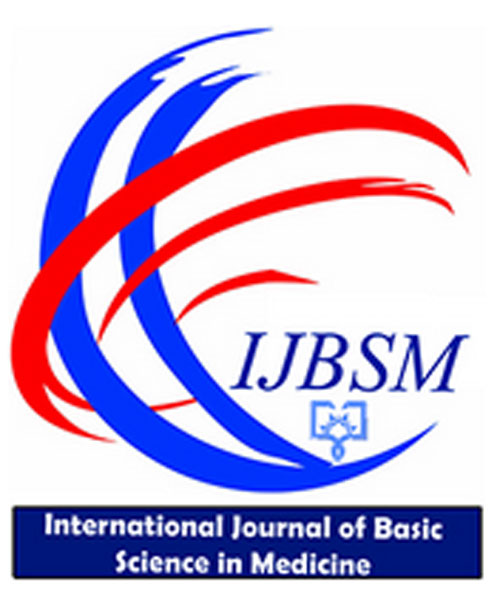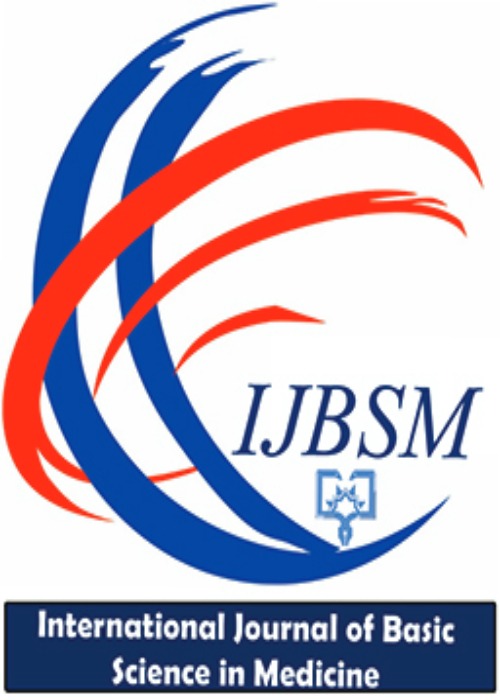فهرست مطالب

International journal of basic science in medicine
Volume:6 Issue: 4, Dec 2021
- تاریخ انتشار: 1401/01/23
- تعداد عناوین: 8
-
-
Pages 119-126Introduction
Improving the non-medical performance of health systems is important because it is an integral part of increasing the welfare of people, which is the public and ultimate mission of the health system. On the other hand, the growth of people’s expectations and attention to safety, quality, and justice has increased the pressure to create a responsive health system. The purpose of this study was to review the evidence of each of the different dimensions of health system responsiveness and assess their current status in Iran.
MethodsSix Persian and English databases, including PubMed, Magiran, Iranmedex, SID, Elsevier, and Emerald, and Google Scholar search engine were searched from the beginning of 2000 to the end of 2020. In order to search for sources, English or Persian equivalents of the keywords of health responsiveness, health evaluation, health performance, accountability, health goals, health monitoring, patient satisfaction, patient expectancies, inpatient services, and patient rights were searched. After careful studying of relevant articles, finally, six eligible studies entered into meta-analysis.
ResultsOut of a total of 571 articles found, six studies were included in the meta-analysis. Findings of these studies showed that the overall response rate after combining the results of these six studies was equal to 60.8% (95% CI: 54.1-68.9). The confidentiality dimension with 72.1% (95% CI: 64.6-81.3) and the right to choose parameters with 55.1% (95% CI: 45.5-68.4) had the highest and lowest responsiveness, respectively.
ConclusionStudies have shown that the confidentiality of personal information, respect for their dignity and support had the highest performance and the right to choose a doctor and independence and attention, and care had the lowest performance. Therefore, it is suggested that in order to make the health system accountable, reforms should be made in these areas simultaneously with the implementation of the health system transformation plan.
Keywords: Health system, Responsiveness, Evaluation, Iran, Systematic review -
Pages 127-131Introduction
Millions of patients suffer from stroke every year, and it is very important for physiotherapists to keep in touch with patients through models that provide physiotherapy over a distance, especially at the time of the COVID-19 pandemic. One key topic within the realm of provision of distance physiotherapy services is "TeleRehab" technology, short form for telerehabilitation. Moreover, the analysis of the gathered stroke data needs business intelligence (BI) technologies, which can help to gain insights into risk factors and improve medical decision-making.
MethodsThis research consists two sections: (a) an online web-based intelligence dashboard was implemented, which provides analyzing the clinical data of 1219 patients and investigating risk the factors of ischemic versus hemorrhagic stroke; and (b) designing a mobile application that can be run on both Android and iOS operating systems, which was successfully tested, as an TeleRehab solution.
ResultsThe designed intelligence dashboard was equipped with a geographical information system (GIS) system that provided the possibility for the analysis of stroke status in any geographical location and discovering the relationships between patient-related contributors in each type of stroke.
ConclusionsBoth of these products can help patients undergoing medical rehabilitation, especially during COVID-19 conditions. The TeleRehab program is considered as a facilitator, especially at this time when keeping a social distance is necessary, to prevent exacerbation of patients’ complications and reduce the work burden on health personnel. The intelligence dashboard also provided a user-friendly tool for the analysis and running of queries about stroke for decision-making.
Keywords: Telerehabilitation, COVID-19, Mobile application, Stroke, Smart dashboard -
Pages 132-138Introduction
Diabetes is related to the higher production of inflammatory markers such as chemerin and resistin. Hypoglycemic influences of Eryngium thyrsoideum Boiss and silver nanoparticles (SNPs) have been established. The present study investigated the impacts of chemically or biologically synthesized SNPs using E. thyrsoideum extract on chemerin and resistin gene expressions in type II diabetic rats.
MethodsTwenty male Wistar rats weighing 180-200 g were used. Type 2 diabetes was induced by nicotinamide and streptozotocin. Saline and 2.5 mg/kg chemically or biologically synthesized SNPs were injected to diabetic rats for two weeks. Five healthy rats received saline for two weeks. One day after the last injection, fasting blood samples were collected. Mean serum concentrations of glucose, creatinine, urea, alanine aminotransferase (ALT), and aspartate aminotransferase (AST) were measured by spectrophotometry. The gene expression of chemerin and resistin was determined by real-time polymerase chain reaction (PCR).
ResultsMean serum concentrations of glucose, urea, ALT, AST, and mean relative gene expression of chemerin and resistin remarkably decreased in the diabetic group receiving SNPs prepared by either the chemical method or using Eryngium extract compared to the diabetic control group. Serum creatinine concentration did not change significantly in the control diabetic or diabetic groups receiving SNPs prepared either chemically or using the Eryngium extract.
ConclusionChemically or green synthesized SNPs prevent liver hepatocyte damage. They reduced inflammatory factors via exerting hypoglycemic effects.
Keywords: Eryngium thyrsoideum, Silver nanoparticles, Chemerin, Resistance -
Pages 139-144Introduction
Today, the resistance of pathogens to antibiotics, as well as the side effects of chemical drugs, have led to our increasing use of medicinal plants. So, our purpose was to investigate the antibacterial and antifungal effects of leaves and flowers’ methanolic extracts of Lantana camara L.
MethodsIran’s National Botanical Garden (Tehran, Iran) provided the plant, whose leaves and flowers’ methanolic extracts were prepared by the percolation method. The antimicrobial activity was measured by the disc-diffusion method against some bacteria (gram-negative and gram-positive), as well as fungi. Minimum inhibitory concentration (MIC) was determined by the serial dilution method and determining the diameter of the growth inhibition zone. Data were analyzed by Duncan test, and P < 0.05 was designated as the significance level.
ResultsThe results confirmed that the extracts had antimicrobial activities against the microorganisms tested with more potent activity against gram-positive bacteria, gram-negative bacteria, and then fungi, respectively. Antimicrobial activity increased with rising the concentration of the extracts. The extracts of leaves and flowers showed comparable antimicrobial activity (P > 0.05). Staphylococcus aureus showed the highest sensitivity at the 50% concentration of the leave and flower extracts (29.66 ± 1.15 and 30.33 ± 0.66, respectively), and Escherichia coli showed the least sensitivity at the 6.25 % concentration of the leave and flower extracts (2.66 ± 0.88 and 1.00 ± 1.15, respectively). The most potent antifungal activity was seen against Candida albicans at the 50% concentration of the leave extract (14.00 ± 0.45), and the lowest antifungal activity was seen against Aspergillus niger at the 12.25% concentration of the flower extract (1.33 ± 0.66).
ConclusionLantana camara leaves and flowers’ extracts showed potential to be used as anti-microbial agents against bacterial and fungal infections.
Keywords: Antibacterial activity, Antifungal activity, Lantana camara L., Methanolic extract -
Pages 145-151Introduction
Patients with dental anxiety avoid receiving medical care. This anxiety poses a threat to oral health. The present study aimed to investigate the effectiveness of muscle relaxation training and mindfulness training on fear and resilience in patients with dental anxiety.
MethodsThis was a clinical trial (pretest-posttest design and a control group). The statistical population comprised all patients with dental anxiety who went to dental clinics in the city of Ahvaz in 2018-2019. The research sample included 45 patients with dental anxiety selected through convenience sampling. The participants were randomly divided into two experimental (muscle relaxation training and mindfulness training) and one control group (n = 15 each). The research tools included the Dental Fear Survey (DFS), the Connor-Davidson Resilience Scale (CD-RISC), and the Modified Dental Anxiety Scale (MDAS). Multivariate analysis of covariance was used to analyze the data.
ResultsThe mean ± standard deviation (SD) of the post-test scores of fear and resilience were 49.53 ± 9.67 and 84.80 ± 7.89 in the muscle relaxation training group and 58.26 ± 12.67 and 55.60 ± 8.83 in the mindfulness training group, which were significantly different from the control groups (83.80 ± 3.50 and 40.46 ± 5.65). Muscle relaxation training reduced fear and increased resilience in patients with dental anxiety in the experimental groups compared to the control group (P < 0.001). Furthermore, in terms of fear and resilience in patients with dental anxiety, muscle relaxation training and mindfulness training were significantly different (P < 0.001).
ConclusionIn addition to decreasing fear, muscle relaxation training and mindfulness can increase resilience in patients with dental anxiety. Also, muscle relaxation training was more effective than mindfulness training in reducing fear and increasing resilience in patients with dental anxiety.
Keywords: Muscle relaxation, Mindfulness, Fear, Resilience, Dental anxiety -
Pages 152-156Introduction
The complement system, consisting of more than 20 soluble proteins, has a crucial role in innate immunity and inflammation and eliminates pathogens and viral infections. Therefore, we investigated the titers of C3, C4, and total IgG in the sera of non-severe and severe coronavirus disease 2019 (COVID-19) patients.
MethodsFor this purpose, peripheral blood samples were collected from 30 non-severe and 30 severe COVID-19 patients and 30 healthy individuals with similar age and sex as the control group. The serum levels of total IgG, C3, and C4 were analyzed. Also, white blood cells, platelets (PLTs), and lymphocytes were counted by an auto-analyzer.
ResultsWhite blood cell count showed no difference between COVID-19 patients and the control group. The results showed a significant decrease in lymphocyte and PLT counts in COVID-19 patients compared to the control. Complement proteins, including C3 and C4, were increased in non-severe COVID-19 patients (C3; P = 0.017 and C4; P = 0.012) compared to other groups. Total IgG showed a notable decrease in severe COVID-19 patients.
ConclusionThe decrease in C3 and C4 complement factors in severe COVID-19 patients may be due to further consumption secondary to the formation of immune complexes. By clarifying the role of complement proteins of C3 and C4 in different stages of the disease, our results can be helpful in designing therapeutic and diagnostic measures for the disease.
Keywords: COVID-19, Complement, C3, C4, IgG, Inflammation -
Pages 157-162Introduction
The novel coronavirus pandemic has ravaged the word since late 2019 and caused many deaths among populations. Our aim was to study clinico-demographic features in middle- and older-aged coronavirus disease 2019 (COVID-19) deceased patients.
MethodsThe present cross-sectional study was done in the Department of Biochemistry, in collaboration with the Department of Medicine, in a tertiary care hospital in Mumbai, India. The clinico-demographic data of COVID-19 positive deceased patients who died at our centre during the period of April 1, 2020 to April 30, 2020 were procured. The diagnosis of COVID-19 was based on reverse transcriptase–polymerase chain reaction (RT-PCR) test results. A total of 110 patients were included in the study and categorized according to their age into three groups: (1) young adults (aged 18-35 years), (2) middle-aged adults (aged 36-55 years), and (3) older adults (aged > 55 years), and various clinico-demographic features were evaluated. The Mann-Whitney U test for non-parametric data and unpaired t-test for the parametric data were used for comparisons.
ResultsThe incidence of COVID-19 was found to be significantly higher in the older age group (P = 0.0001). Diabetes (43.6%) and hypertension (40.9%) were the most common comorbidities present in nearly half of the study population. The median age of the patients died due to COVID-19 was 57.0 years, and there was a higher percentage of men (67.3%) compared to women (32.7%) among the deceased. Clinical and biochemical parameters were compared between middle-aged and older-aged groups. Hypertension and diabetes were significantly higher in the older-aged group compared to the middle-aged group (P < 0.001). No significant difference could be observed in the sign and symptoms and biochemical parameters between these groups.
ConclusionThe clinico-demographic features and mortality in middle-aged and older-aged deceased COVID-19 patients were similar. Close monitoring and early therapeutic interventions in both age groups will help to diminish mortality.
Keywords: COVID-19, Clinical factors, Demographic features, Mortality, Coronavirus, Pandemic


